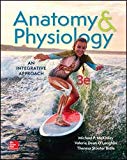
Loose Leaf For Anatomy & Physiology: An Integrative Approach
3rd Edition
ISBN: 9781260162493
Author: McKinley Dr., Michael; O'Loughlin, Valerie; Bidle, Theresa
Publisher: McGraw-Hill Education
expand_more
expand_more
format_list_bulleted
Question
Chapter 16.1, Problem 3WDL
Summary Introduction
To define:
The working of sensory receptors on the basis of modality, location, intensity, and duration of the stimulus.
Concept introduction:
The sensory receptors convert the energy generated by stimulus into the electrical energy. They send the information to
Expert Solution & Answer
Want to see the full answer?
Check out a sample textbook solution
Students have asked these similar questions
Define the “adequate stimulus” of a sensory receptor.
Explain how sensory receptors provide input regarding the modality, location, intensity, and duration of a stimulus.
List the different types of receptors and the type of stimulus to which they respond.
Chapter 16 Solutions
Loose Leaf For Anatomy & Physiology: An Integrative Approach
Ch. 16.1 - LEARNING OBJECTIVE
1. Describe the general...Ch. 16.1 - How does a sensory receptor function as a...Ch. 16.1 - Prob. 2LOCh. 16.1 - Prob. 2WDLCh. 16.1 - Prob. 3LOCh. 16.1 - Prob. 4LOCh. 16.1 - Prob. 3WDLCh. 16.1 - Prob. 5LOCh. 16.1 - LEARNING OBJECTIVE
6. Classify the various types...Ch. 16.1 - Prob. 4WDL
Ch. 16.2 - Prob. 7LOCh. 16.2 - What are the three types of unencapsulated tactile...Ch. 16.2 - Prob. 8LOCh. 16.2 - Prob. 6WDLCh. 16.3 - Prob. 9LOCh. 16.3 - Prob. 10LOCh. 16.3 - What is the role of the mucus in detection of...Ch. 16.3 - Prob. 8WDLCh. 16.3 - Prob. 11LOCh. 16.3 - Prob. 12LOCh. 16.3 - Prob. 13LOCh. 16.3 - Prob. 1WDTCh. 16.3 - Prob. 9WDLCh. 16.3 - Prob. 10WDLCh. 16.4 - LEARNING OBJECTIVE
14. Describe the accessory...Ch. 16.4 - Prob. 11WDLCh. 16.4 - Prob. 12WDLCh. 16.4 - Prob. 15LOCh. 16.4 - What are the three eye tunics; what is the primary...Ch. 16.4 - Compare the anatomic structure of the cornea and...Ch. 16.4 - What are the functions of the vitreous humor and...Ch. 16.4 - Prob. 16LOCh. 16.4 - Prob. 17LOCh. 16.4 - Prob. 16WDLCh. 16.4 - Prob. 18LOCh. 16.4 - Prob. 19LOCh. 16.4 - LEARNING OBJECTIVE
20. Explain the bleaching...Ch. 16.4 - What are the differences between rods and cones...Ch. 16.4 - How does dark adaptation differ from light...Ch. 16.4 - What occurs during phototransduction of light?Ch. 16.4 - Prob. 21LOCh. 16.4 - Prob. 22LOCh. 16.4 - Prob. 2WDTCh. 16.4 - Prob. 20WDLCh. 16.4 - Prob. 21WDLCh. 16.5 - Prob. 23LOCh. 16.5 - Prob. 24LOCh. 16.5 - Prob. 25LOCh. 16.5 - Prob. 3WDTCh. 16.5 - Prob. 22WDLCh. 16.5 - Prob. 23WDLCh. 16.5 - Prob. 24WDLCh. 16.5 - Prob. 26LOCh. 16.5 - Prob. 27LOCh. 16.5 - Prob. 28LOCh. 16.5 - What are the steps for detecting sounds?Ch. 16.5 - Compare the difference in how we perceive pitch...Ch. 16.5 - Prob. 29LOCh. 16.5 - Prob. 27WDLCh. 16.5 - Prob. 30LOCh. 16.5 - Prob. 31LOCh. 16.5 - Prob. 32LOCh. 16.5 - Prob. 28WDLCh. 16.5 - Prob. 29WDLCh. 16 - Prob. 1DYBCh. 16 - Prob. 2DYBCh. 16 - Prob. 3DYBCh. 16 - Prob. 4DYBCh. 16 - Prob. 5DYBCh. 16 - Prob. 6DYBCh. 16 - _____ 7. Which ear structure is correctly matched...Ch. 16 - Prob. 8DYBCh. 16 - Prob. 9DYBCh. 16 - Prob. 10DYBCh. 16 - Prob. 11DYBCh. 16 - Prob. 12DYBCh. 16 - Prob. 13DYBCh. 16 - Prob. 14DYBCh. 16 - Prob. 15DYBCh. 16 - Prob. 16DYBCh. 16 - Prob. 17DYBCh. 16 - Prob. 18DYBCh. 16 - Describe the pathway by which sound waves enter...Ch. 16 - Explain how the vestibule and semicircular canals...Ch. 16 - Prob. 1CALCh. 16 - Prob. 2CALCh. 16 - Prob. 3CALCh. 16 - Prob. 4CALCh. 16 - Prob. 5CALCh. 16 - Prob. 1CSLCh. 16 - Prob. 2CSLCh. 16 - Prob. 3CSL
Knowledge Booster
Similar questions
- Name six categories of sensory receptors and the type of stimulus that each type detects.arrow_forwardAwareness of a stimulus is called a ________.arrow_forwardMatch each of the following terms with the appropriate description. _____ somatic senses (general senses)a.produced by strong stimulation _____ special sensesb.endings of sensory neurons or specialized cells next to them _____ variations in stimulus intensity _____ action potentialc.taste, smell, hearing, balance, and vision _____ sensory receptord.frequency and number of action potentials e.touch, pressure, temperature, pain, and muscle sensearrow_forward
- When a receptor cell detects a specific kind of stimulus, what happens to the stimulus energy?arrow_forwardClassify sensory receptors according to body location, stimulus detected, and structure.arrow_forwardEnumerate the receptors classified on the type of stimulus. Describe their characteristics in detail. Also write the characteristics and function of Nociceptors. I. ATES)arrow_forward
- Please describe the difference between threshold stimulus and sub-maximal stimulus.arrow_forwardDescribe each of the following types of receptors, indicating what sensation it detects and giving an example of where it can be found in the body: pain receptors (nociceptors), temperature receptors,mechanoreceptors (including proprioceptors and barorceptors/pressoreceptors), chemoreceptors, and photoreceptors.arrow_forward
arrow_back_ios
arrow_forward_ios
Recommended textbooks for you
 Human Physiology: From Cells to Systems (MindTap ...BiologyISBN:9781285866932Author:Lauralee SherwoodPublisher:Cengage Learning
Human Physiology: From Cells to Systems (MindTap ...BiologyISBN:9781285866932Author:Lauralee SherwoodPublisher:Cengage Learning Human Biology (MindTap Course List)BiologyISBN:9781305112100Author:Cecie Starr, Beverly McMillanPublisher:Cengage Learning
Human Biology (MindTap Course List)BiologyISBN:9781305112100Author:Cecie Starr, Beverly McMillanPublisher:Cengage Learning

Human Physiology: From Cells to Systems (MindTap ...
Biology
ISBN:9781285866932
Author:Lauralee Sherwood
Publisher:Cengage Learning

Human Biology (MindTap Course List)
Biology
ISBN:9781305112100
Author:Cecie Starr, Beverly McMillan
Publisher:Cengage Learning